The garden at The Impatient Gardener headquarters is our playground, laboratory, testing ground and home. We bought the house and property, which is situated about 400 feet from the shore of Lake Michigan (although there are houses in between) in 2002, and after the obligatory “watch and observe” summer in the garden, I immediately jumped in to putting my stamp on the garden.
The first garden I worked on was directly off the patio (still called the Patio Garden, in my incredibly bland garden-naming strategy). It had been planted with a collection of tall ornamental grasses (other than a few Calamagrostis ‘Karl Foerster’ I couldn’t tell you what they were) that flopped by mid-summer and, it appeared, were home to an impressive population of mice. We brush-mowed the whole lot in fall, and I dug out as many root balls as I could find.
The next spring I planted that garden with passalong plants from my mother and other gardeners, which created a passable design full of happily spreading plants, some of which were so traumatic for me that it took decades to convince me to plant them again.
Zone
USDA Hardiness zone 5b/6a
Size
1.3 acres (about 75% of it is managed, the rest is woodland).
Location
Southeastern Wisconsin, about 400 feet from the shore of Lake Michigan.
Age
Actively gardened (in this iteration) beginning in 2003.
Soil
Mostly alkaline sandy loam with a few surprises thrown in.
Features
Several large, mature trees dominate the landscape, including Norway spruce (Picea abies), American beech (Fagus grandifolia), northern red oak (Quercus rubra), sugar maple (Acer saccharum).
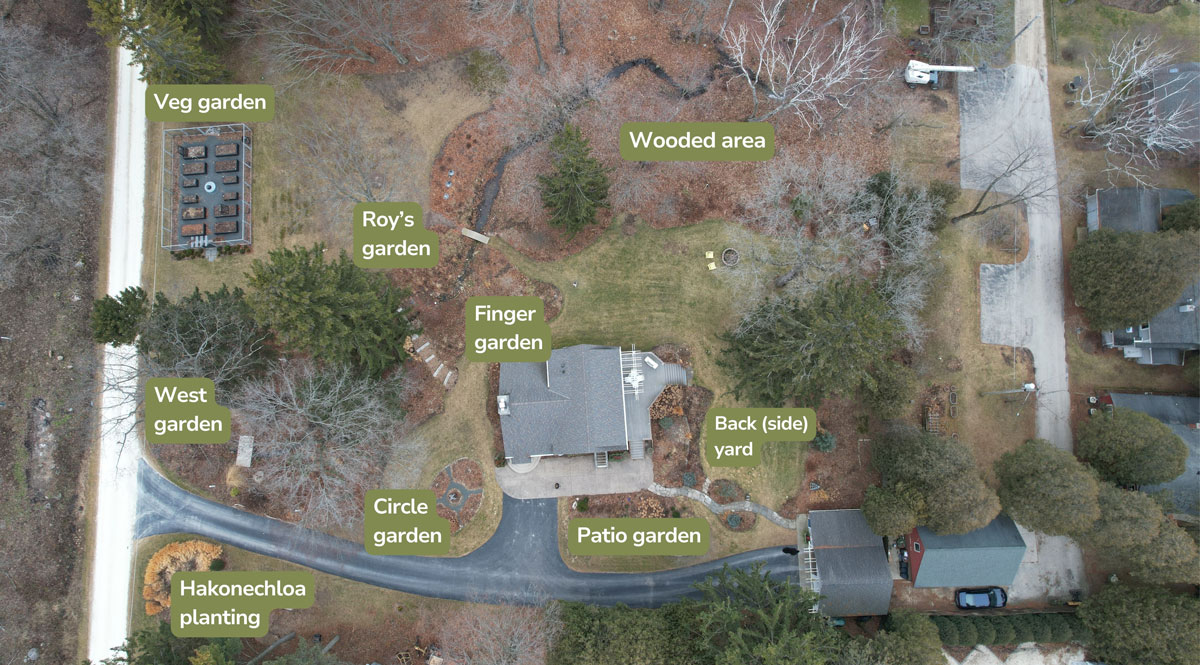
As that garden grew along with my gardening confidence, I started revamping other existing garden areas, including a patch near the front door that had clearly once been a vegetable patch, but had since had a few random plants, including rose of Sharon and some more ‘Karl Foerster’ plunked in it.
This became the Circle Garden, which is not at all a circle, but more of an ellipse. Originally I used this as a sort of decorative garden with one section designated for tomatoes.
Meanwhile I was slowly chipping away at other areas of the yard, tweaking derelict areas of the yard—the house had been used as second home for many years before we bought it—and attempting to create new gardens from naturalized areas.
Many of the plants in my garden were purchased through a plant co-op on a message board (this was pre-Facebook), which supplied us with wholesale plugs for all manner of plants. Many of those plants—particularly hostas—remain in my garden to this day.
One thing I’ve learned in this garden is to never say never, so I have no doubt that new garden areas will be created, but my goal now is to continue refine the various areas of the garden and, of course, keep pushing the envelope and trying new things.
The Timeline
Zone
USDA Hardiness zone 5b/6a
Size
1.3 acres (about 75% of it is managed, the rest is woodland).
Location
Southeastern Wisconsin, about 400 feet from the shore of Lake Michigan.
Age
Actively gardened (in this iteration) beginning in 2003.
Soil
Mostly alkaline sandy loam with a few surprises thrown in.
Features
Several large, mature trees dominate the landscape, including Norway spruce (Picea abies), American beech (Fagus grandifolia), northern red oak (Quercus rubra), sugar maple (Acer saccharum).
The Timeline
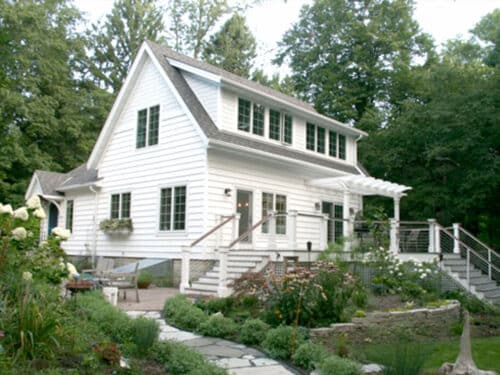
In 2010 we renovated the house, basically picking up the roof and putting it back on taller, giving us more usable space on the second floor and added the deck. This necessitated a redesign (actually more of just a proper design) of what I often call the “back yard” but it’s really the side yard. I installed a small retaining wall to level the area off the deck and built a path from the patio to the detached garage, incorporating bluestone I rescued when my grandmother’s house was torn down.
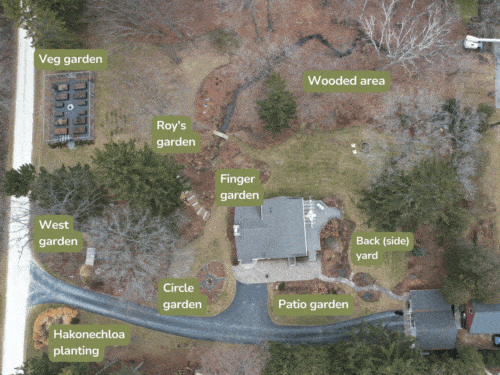
Ever since we moved in I attempted to make something out of what was presumably a former vegetable garden by the front door. By the time we got there it was an eyesore filled with mostly weeds, so I turned it into an elliptical garden with stone edging early on. First, I grew tomatoes and a few other things. Later I moved the tomatoes out and made it an ornamental bed with three odd, curvy paths, but it was never quite right. Finally in 2017 I decided to fix it once and for all and create a formal look with informal planting. Each segment is surrounded by a hedge of chives, a quirky feature that I adore.
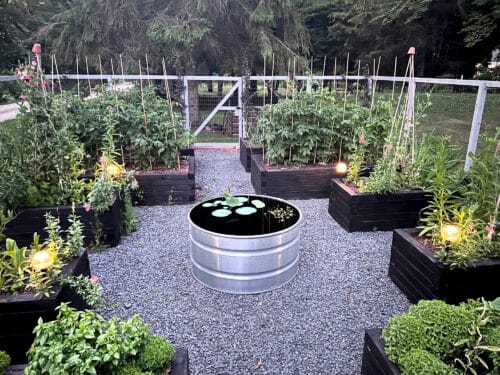
2018 saw the building of the vegetable garden of my dreams. It features 12 tall raised beds in a fenced-in area, a necessity in an area with high deer pressure. There was really only one place on the property where this could go, with just enough sun and enough space to fit it.
Like many areas, emerald ash borer has been devastating in this area, and we’ve lost more than 30 over of the years, and that has led to the development of many more gardens on the property. In 2020 I created a more naturalistic style garden near the road in an area that had previously been dominated by a very large ash tree.
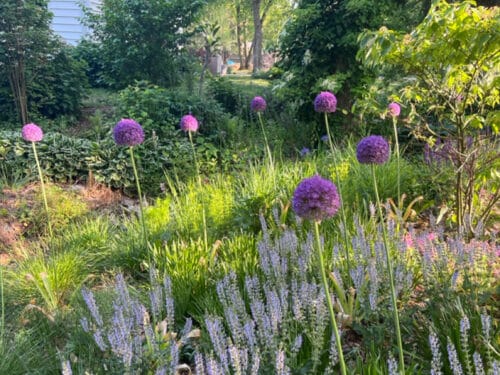
In 2022 I had a wonderful time working with Roy Diblik to design small area of the garden. The process was delightful (Roy is a joy), and the end result is beautiful.
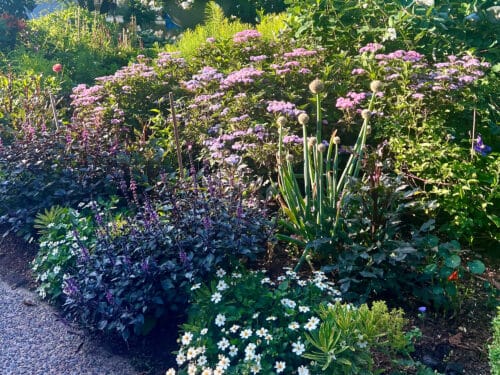
In 2023 we planted a mixed hedge in conjunction with our neighbors to the south. The area to the south of our driveway, most of which is on our neighbors’ property, had been planted with arborvitae that had outgrown their usefulness. They were about 55 feet tall, but had been “pruned” by the deer to 8 feet from the ground, making it useless as a hedge (everything was open at the bottom). We used a mix of evergreens and deciduous trees and shrubs, relying heavily on native species but also including some great non-natives.